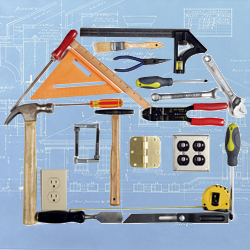
FHA 203k vs Conventional Reno Loan: Choosing the Right Tool for your Fixer Upper
4/3/2024
The allure of transforming a fixer-upper into your dream home is undeniable. But financing such a project requires careful consideration. Two popular options emerge: the FHA 203k loan and the conventional renovation loan. Each offers distinct advantages and caters to different financial profiles. Let's delve into the key differences to help you pick the perfect tool for your renovation journey.

The FHA 203k Loan: A Helping Hand for First-Time Homebuyers and Those with Moderate Credit
The FHA 203k loan, backed by the Federal Housing Administration (FHA), is a godsend for those looking to finance both the purchase and renovation of a property into a single mortgage. This makes it particularly attractive for first-time homebuyers who might not have a large down payment for both the house and the renovations. Additionally, the FHA offers more lenient credit score requirements compared to conventional loans.
Benefits:
- Wrapped-up financing: Combine purchase and renovation costs into one loan.
- Lower down payment: Typically requires a lower down payment compared to conventional renovation loans.
- More flexible credit requirements: Accommodates borrowers with moderate credit scores.
Drawbacks:
- Complex approval process: Requires more paperwork and inspections compared to conventional loans.
- Limited scope for extensive renovations: The standard 203k allows for major renovations, but the streamline 203k has limitations on structural changes.
- Higher mortgage insurance: FHA loans come with mandatory mortgage insurance premiums (MIP) throughout the life of the loan (unless you reach 20% equity).
Conventional Renovation Loan: A Streamlined Option for Those with Strong Credit and Larger Budgets
Conventional renovation loans, offered by private lenders, provide financing specifically for renovations on an existing property you already own. These loans are a good fit for homeowners with strong credit scores and a larger down payment. The approval process is typically faster and less complex compared to the FHA 203k loan. Additionally, there are potentially higher borrowing limits for extensive renovations.
Benefits:
- Faster approval process: Less paperwork and quicker turnaround time compared to the FHA 203k.
- Potentially lower interest rates: May offer lower interest rates than FHA loans, especially for those with excellent credit.
- Greater flexibility for extensive renovations: Can finance larger and more complex renovation projects.
Drawbacks:
- Higher down payment: Typically requires a larger down payment compared to FHA 203k loans.
- Stricter credit requirements: Demands a higher credit score for loan approval.
- Separate financing: Requires separate financing for the purchase (if applicable) and renovations.
So, Which Loan is Right for You?
Here's a quick guide to help you decide:
- You're a first-time homebuyer looking to finance both purchase and renovations.
- You have moderate credit but a smaller down payment for both the house and renovations.
- Your renovation project falls within the scope allowed by the FHA (standard or streamline).
- You already own a home and have strong credit with a larger down payment for renovations.
- You plan for extensive renovations that exceed the scope of the FHA 203k program.
- You prioritize a faster approval process and potentially lower interest rates (depending on your credit score).
The Final Takeaway:
Both the FHA 203k and conventional renovation loans offer valuable tools for financing your dream renovation. Carefully consider your financial situation, creditworthiness, renovation scope, and desired loan features to make an informed decision. Consulting with a qualified mortgage professional can provide valuable guidance and ensure you choose the loan option that best aligns with your unique needs and goals. Now, go forth and transform your fixer-upper into a place you'll love for years to come!
